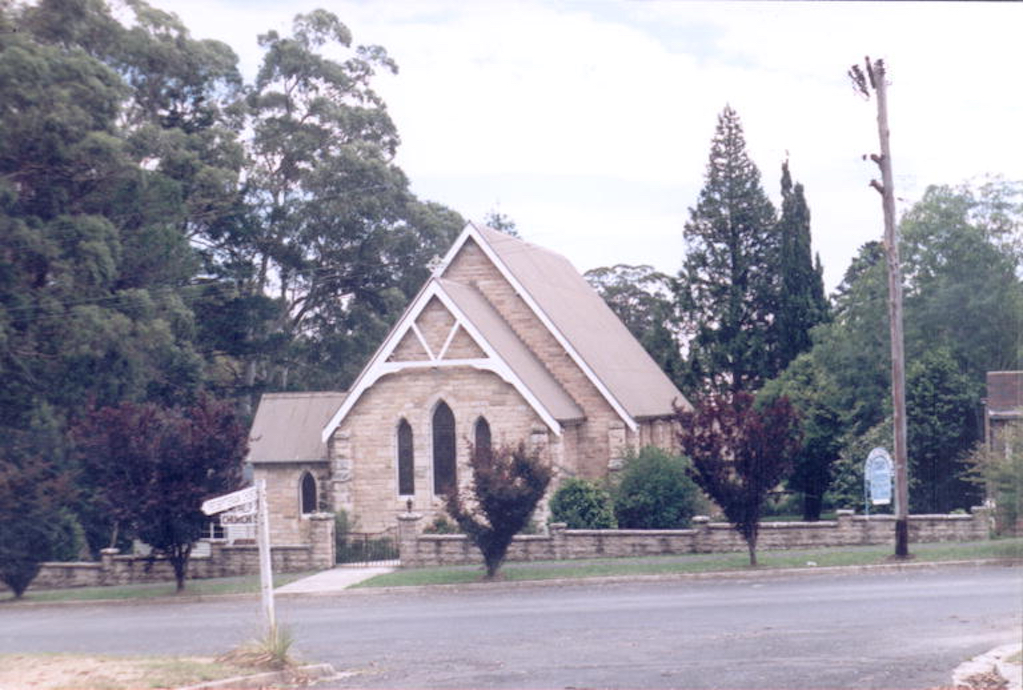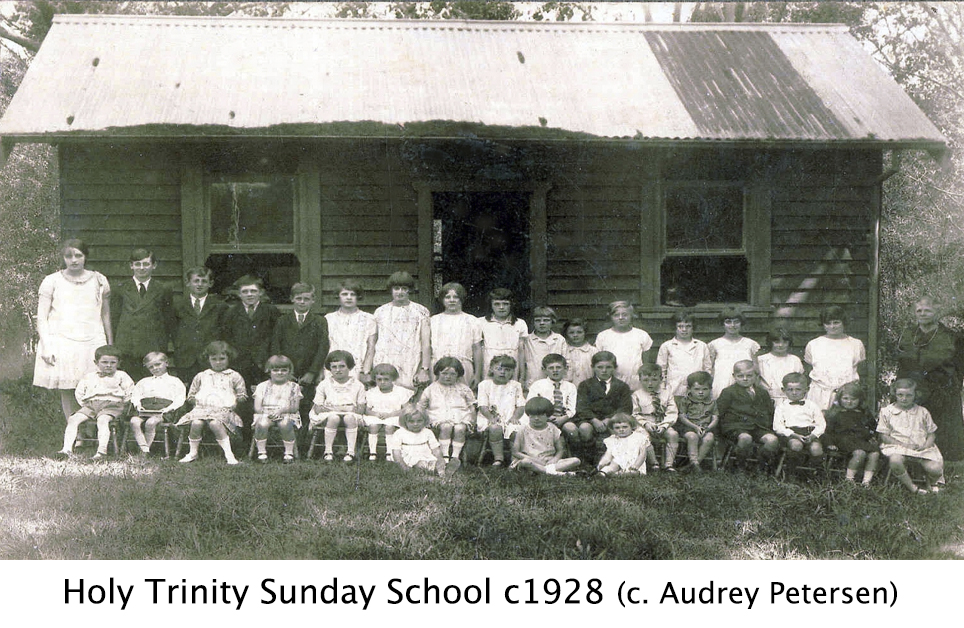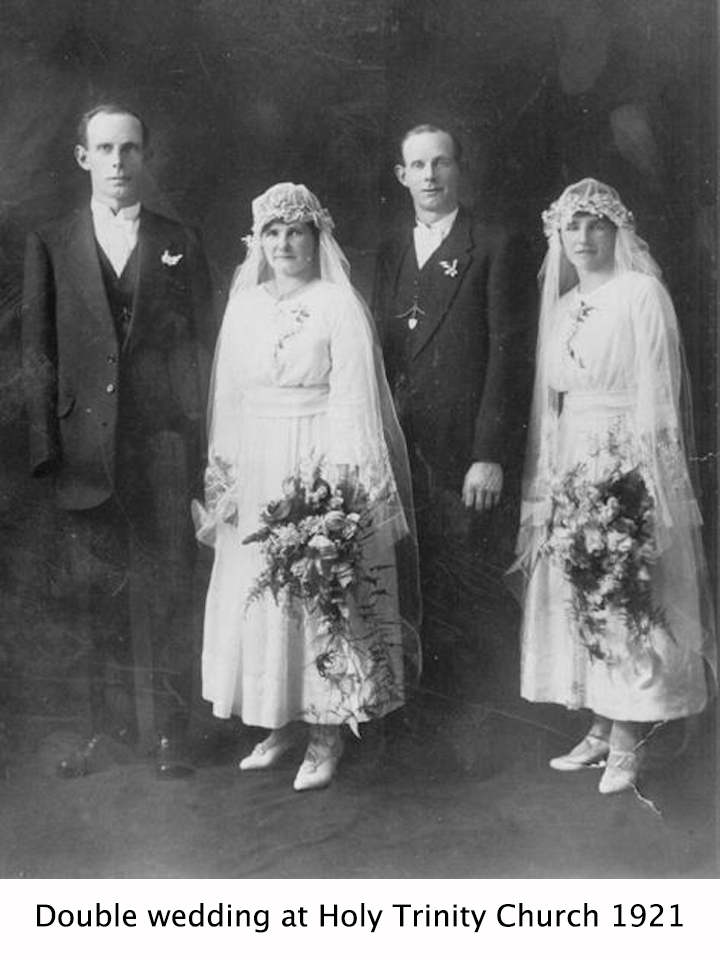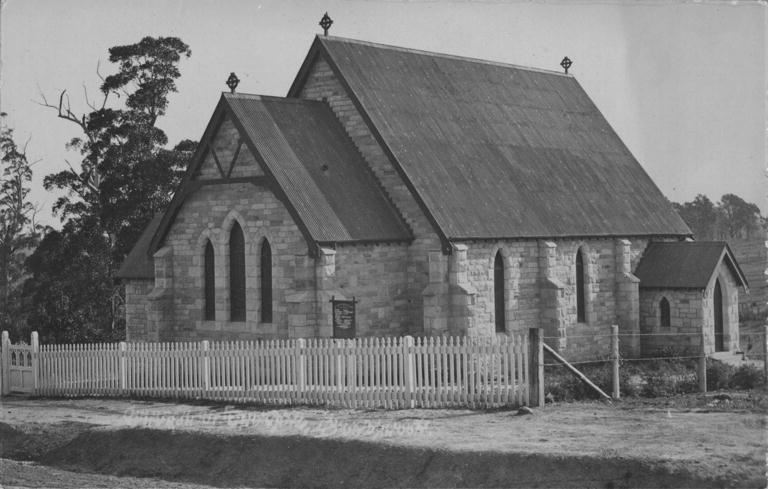The Bundanoon
free Audio Guide app
plus there is more history below if you wish:
Holy Trinity Church
15 Church Street
The first Anglican church
The first Holy Trinity Church at Bundanoon was erected in 1879 on land that was a conditional purchase taken out by Charles Jordon. The land for the church was taken out by way of a Government Grant. Mr W A Nicholas owned the land in about 1884 when his title deeds were issued.
In July 1877 Messrs W A Nicholas and G W Osborn wrote to Bishop Barker of Sydney asking for one of the ministers from either Sutton Forest, Berrima or Bowral to visit Bundanoon (Jordan’s Crossing) once a month. He stated that “Our children are growing up in total ignorance of the Rites of the Established Church”. Samuel Tooth erected a slab church and the portion that was completed was consecrated by Bishop Barker on 9th November 1879. It had neat slab walls, shingle roof, porch and belfry and three English Gothic gable crosses with a circle symbolizing eternity.
A correspondent to the Moss Vale Scrutineer in 1882, writing of the progress being made in Bundanoon, remarked “the Church of England and the Methodist Primitive Church have places of worship not far from the station, but neither edifice is in keeping with the progress of the locality. However, it is said they look better inside than outside, and certainly they would need to be so.”
This building was subsequently burnt down in the disastrous bushfires of December, 1904. On Wednesday January 4 1905, the Scrutineer reported “the fire leapt the road behind the Nicholas’ factory and set fire to the Church of England, which was soon a smouldering heap of ruins”. An entry in the church register reads “January 1st 1905, no service, church burnt”. It seems the Bible was the only thing saved.
The Current Church

The foundation stone of the present Holy Trinity Church was laid by Governor Sir Harry Rawson on Wednesday, 8th March, 1905. The building, a rubble structure, was opened in 1905 but was not dedicated until 18 January 1907 by the Archbishop of Sydney, William Saumarez Smith. While the building was being erected services were held in the Methodist Church. Messrs Nicholas, Osborne, Clarke and two schoolteachers were the guarantors of the new building.

Expert tradesmen and suppliers
The new church, which cost £530, was erected by J R W Walker of Kareela. Mr Walker was contractor, architect and supervisor. Mr T Shepherd and his son from Bowral did the stonework, and George W. Layton, a stonemason of Penrose, dressed the windowsills. The sandstone came from near a coalmine halfway between Bundanoon and Penrose. Joe Tooth, who had a sawmill in the Bundanoon Gully, supplied the hardwood. John Walker was assisted by his elder son Rob, while his younger son Percy helped mainly with the cartage of timber and other building materials especially from the railway. The softwood and iron came from Sydney.
In April 1982, John Walker’s younger son Percy, then 92, visited the Church and signed the Visitors Book. He was delighted at the excellent condition of the Church and lovingly declared the floor to be as sound as the day they laid it down. It was obvious that the building of the Church was a tremendous highlight in his life and he remembered many details with great joy and satisfaction. He recalled it was very cold while they were building and they wore two pairs of trousers and three shirts and worked hard to keep out the cold.

The Walkers were expert carpenters. Percy said “My father was a thorough tradesman, a fast worker and a hard worker and he expected everyone else to be the same. He was very particular about his work and if it wasn’t done properly, it had to be done over again. My brother and I did a lot of lathe work at night by the light of an old kerosene lantern. He worked the lathe by standing side by side on one foot and pedalling with the other.” They took great care putting on the roof, working from a wooden ladder tied by a rope over the ridge to a tree, punching and boring holes with a brace and bit for the galvanized roofing screws with their lead washers and having someone sight up the 3 sheets of iron from the ground to keep them in line.
Church features
On August 19th. 1905, The Scrutineer reported:
“BUNDANOON. The new Church of England building is now completed, and has quite an imposing appearance. The interior walls are plastered and coloured French grey with varnished ceiling. The windows are lead lights of bright ruby with border of dark ruby and green glass. The three memorial windows in the eastern end, to the memory of the late Mrs Widgery and Mrs Nicholas, have been designed and executed by Mr Sugarman of Kogarah, and are very much admired. Great praise is due to Mr Walker, (the contractor and builder), Mr Shepherd (the stonemason), and Mr Sugarman for the way in which they have performed their work”.

Two features of the Church are the beautiful white wooden Crosses on the ridges above the gables and the great V for Victory below the front cross. These simple English Gothic crosses are partly of Maltese Cross shape (symbolizing healing and encompassed in a circle symbolizing Eternity). There were originally 3 such gable Crosses on the first Church.
Three beautiful windows adorn the East end of the building (in memory of Mary Ann Widgery who died 9th March 1900 aged 96). One window shows the Holy Spirit as a dove descending, the other the Lamb of God with a banner of love on either side of the lovely central window with its colourful ‘IHS’ (a monogram symbolising Jesus Christ) and seven golden orbs (in memory of Sarah Nicholas).
A graveyard was established behind the church and was in use from 1850 to 1929. There are 19 graves with 29 names recorded, including some of Bundanoon’s well-known early families. The first recorded burial was that of Amy Eliza Nicholas, daughter of William Augustus and Sarah Nicholas, who died on 6th September1880 aged 11 years.

